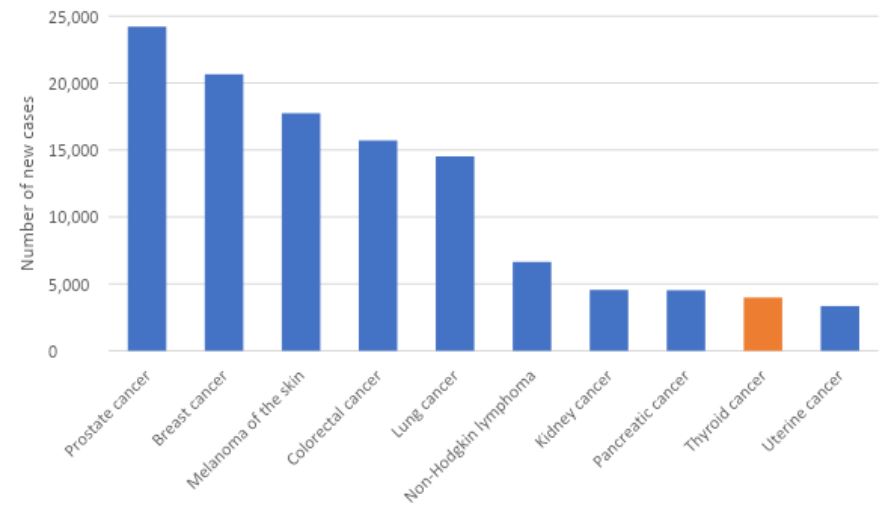The following material has been sourced from the Australian Institute of Health and Welfare
Thyroid cancer incorporates ICD-10 cancer code C73 (Malignant neoplasm of thyroid gland).
Estimated number of new cases of thyroid cancer diagnosed in 2022
3,981 =  1,152 males +
1,152 males +  2,829 females
2,829 females
Estimated % of all new cancer cases diagnosed in 2022
2.5%
Estimated number of deaths from thyroid cancer in 2022
143 =  72 males +
72 males +  71 females
71 females
Estimated % of all deaths from cancer in 2022
0.29%
Chance of surviving at least 5 years (2014–2018)
97%
People living with thyroid cancer at the end of 2017 (diagnosed in the 5 year period 2013 to 2017)
13,974
New cases
Thyroid cancer was the ninth most commonly diagnosed cancer in Australia in 2018. It is estimated that it will remain the ninth most commonly diagnosed cancer in 2022.
In 2018, there were 3,399 new cases of thyroid cancer diagnosed in Australia (984 males and 2,415 females). In 2022, it is estimated that 3,981 new cases of thyroid cancer will be diagnosed in Australia (1,152 males and 2,829 females). In 2022, it is estimated that a person has a 1 in 80 (or 1.3%) risk of being diagnosed with thyroid cancer by the age of 85 (1 in 136 or 0.74% for males and 1 in 57 or 1.8% for females).

Figure 1. Estimated cancer incidence in Australia, 2022
Notes
- Data sourced from AIHW Cancer Data in Australia 2022 web report and supplementary data tables
- More information about incidence rates for the most common cancers diagnosed can be found on the NCCI website in the ‘Cancer incidence’ section (https://ncci.canceraustralia.gov.au/diagnosis/cancer-incidence/cancer-incidence)
In 2018, the age-standardised incidence rate was 13 cases per 100,000 persons (7.5 for males and 18 for females). In 2022, it is estimated that the age-standardised incidence rate will be 14 cases per 100,000 persons (8.2 for males and 20 for females). The incidence rate for thyroid cancer is expected to increase with age, highest for those aged 65–69 years.

Figure 2. Age-standardised incidence rates for thyroid cancer, 1982 to 2018, by sex
Notes:
- Data sourced from AIHW Cancer Data in Australia 2022 web report and supplementary data tables
- More information about incidence rates for thyroid cancer over time, by age, sex, Indigenous status, remoteness, and socioeconomic status (SES) can be found on the NCCI website in the ‘Cancer incidence’ section (https://ncci.canceraustralia.gov.au/diagnosis/cancer-incidence/cancer-incidence)
The number of new cases of thyroid cancer diagnosed increased from 362 (104 males and 258 females) in 1982 to 3,399 in 2018. Over the same period, the age-standardised incidence rate increased from 2.7 cases per 100,000 persons (1.6 for males and 3.7 for females) in 1982 to 13 cases per 100,000 in 2018.
Deaths
In 2020, there were 112 deaths from thyroid cancer in Australia (48 males and 64 females). In 2022, it is estimated that there will be 143 deaths (72 males and 71 females). In 2022, it is estimated that a person has a 1 in 2,435 (or 0.04%) risk of dying from thyroid cancer by the age of 85 (1 in 2,355 or 0.04% for males and 1 in 2,514 or 0.04% for females).

Figure 3. Estimated cancer mortality in Australia, 2022
Notes
- Data sourced from AIHW Cancer Data in Australia 2022 web report and supplementary data tables
- More information about mortality rates for the most common causes of cancer death can be found on the NCCI website in the ‘Cancer mortality’ section (https://ncci.canceraustralia.gov.au/outcomes/cancer-mortality/cancer-mortality)
In 2020, the age-standardised mortality rate was 0.3 deaths per 100,000 persons (0.3 for males and 0.4 for females). In 2022, it is estimated that the age-standardised mortality rate will be 0.4 deaths per 100,000 persons (0.5 for males and 0.4 for females). The mortality rate for thyroid cancer is expected to increase with age.

Figure 4. Age-standardised mortality rates for thyroid cancer, 1982 to 2020, by sex
Notes:
- Data sourced from AIHW Cancer Data in Australia 2022 web report and supplementary data tables
- More information about mortality rates for thyroid cancer over time, by age, sex, Indigenous status, remoteness, and socioeconomic status (SES) can be found on the NCCI website in the ‘Cancer mortality’ section (https://ncci.canceraustralia.gov.au/outcomes/cancer-mortality/cancer-mortality)
The number of deaths from thyroid cancer increased from 73 (27 males and 46 females) in 1982 to 112 in 2020. Over the same period, the age-standardised mortality rate remained similar from 0.6 deaths per 100,000 persons (0.5 for males and 0.7 for females) in 1982 to 0.3 deaths per 100,000 in 2020.
Survival
In 2014–2018, individuals diagnosed with thyroid cancer had a 97% chance (93% for males and 98% for females) of surviving for five years compared to their counterparts in the general Australian population. Between 1989–1993 and 2014–2018, five-year relative survival for thyroid cancer improved from 89% to 97%.

Figure 5. 5-year relative survival for thyroid cancer, 1989–1993 to 2014–2018, by sex
Notes:
- Data sourced from AIHW Cancer Data in Australia 2022 web report and supplementary data tables
- More information about 5-year relative survival rates for thyroid cancer over time, by age, sex, Indigenous status, remoteness, and socioeconomic status (SES) can be found on the NCCI website in the ‘Relative survival rate’ section (https://ncci.canceraustralia.gov.au/outcomes/relative-survival-rate/5-year-relative-survival-diagnosis)
Prevalence
At the end of 2017, there were 3,073 people living who had been diagnosed with thyroid cancer that year, 13,974 people living who had been diagnosed with thyroid cancer in the previous 5 years (from 2013 to 2017) and 40,559 people living who had been diagnosed with thyroid cancer in the previous 36 years (from 1982 to 2017).
For more information, see Thyroid cancer on the NCCI website
The National Cancer Control Indicators (NCCI) are a set of indicators across the continuum of cancer care, from Prevention and Screening through to Diagnosis, Treatment, Psychosocial care, Research and Outcomes. The NCCI website allows users to see visual representations of data on each indicator through interactive charts.




